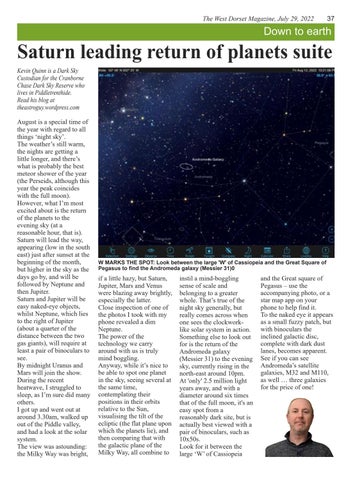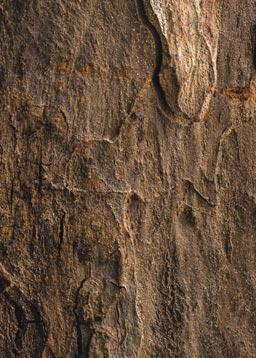The West Dorset Magazine, July 29, 2022
37
Down to earth
Saturn leading return of planets suite Kevin Quinn is a Dark Sky Custodian for the Cranborne Chase Dark Sky Reserve who lives in Piddletrenthide. Read his blog at theastroguy.wordpress.com August is a special time of the year with regard to all things ‘night sky’. The weather’s still warm, the nights are getting a little longer, and there’s what is probably the best meteor shower of the year (the Perseids, although this year the peak coincides with the full moon). However, what I’m most excited about is the return of the planets to the evening sky (at a reasonable hour, that is). Saturn will lead the way, appearing (low in the south east) just after sunset at the beginning of the month, but higher in the sky as the days go by, and will be followed by Neptune and then Jupiter. Saturn and Jupiter will be easy naked-eye objects, whilst Neptune, which lies to the right of Jupiter (about a quarter of the distance between the two gas giants), will require at least a pair of binoculars to see. By midnight Uranus and Mars will join the show. During the recent heatwave, I struggled to sleep, as I’m sure did many others. I got up and went out at around 3.30am, walked up out of the Piddle valley, and had a look at the solar system. The view was astounding: the Milky Way was bright,
XX
W MARKS THE SPOT: Look between the large 'W' of Cassiopeia and the Great Square of Pegasus to find the Andromeda galaxy (Messier 31)0
if a little hazy, but Saturn, Jupiter, Mars and Venus were blazing away brightly, especially the latter. Close inspection of one of the photos I took with my phone revealed a dim Neptune. The power of the technology we carry around with us is truly mind boggling. Anyway, while it’s nice to be able to spot one planet in the sky, seeing several at the same time, contemplating their positions in their orbits relative to the Sun, visualising the tilt of the ecliptic (the flat plane upon which the planets lie), and then comparing that with the galactic plane of the Milky Way, all combine to
TREE SURGERY &
GARDEN MAINTENANCE
07826 030706
stevettg@hotmail.com
instil a mind-boggling sense of scale and belonging to a greater whole. That’s true of the night sky generally, but really comes across when one sees the clockworklike solar system in action. Something else to look out for is the return of the Andromeda galaxy (Messier 31) to the evening sky, currently rising in the north-east around 10pm. At 'only' 2.5 million light years away, and with a diameter around six times that of the full moon, it's an easy spot from a reasonably dark site, but is actually best viewed with a pair of binoculars, such as 10x50s. Look for it between the large ‘W’ of Cassiopeia
and the Great square of Pegasus – use the accompanying photo, or a star map app on your phone to help find it. To the naked eye it appears as a small fuzzy patch, but with binoculars the inclined galactic disc, complete with dark dust lanes, becomes apparent. See if you can see Andromeda’s satellite galaxies, M32 and M110, as well … three galaxies for the price of one!








